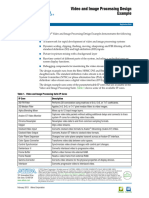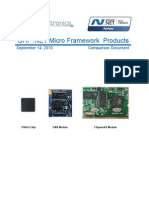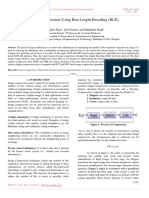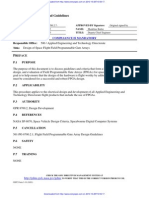h264 Cabac Prodbrief Ds602
h264 Cabac Prodbrief Ds602
Uploaded by
Israa MahmoodCopyright:
Available Formats
h264 Cabac Prodbrief Ds602
h264 Cabac Prodbrief Ds602
Uploaded by
Israa MahmoodCopyright
Available Formats
Share this document
Did you find this document useful?
Is this content inappropriate?
Copyright:
Available Formats
h264 Cabac Prodbrief Ds602
h264 Cabac Prodbrief Ds602
Uploaded by
Israa MahmoodCopyright:
Available Formats
- THIS IS A DISCONTINUED IP CORE 0
H.264 CABAC Core v1.0
DS602 (v1.0) May 15, 2007
0 0
Product Brief
Features
H.264/MPEG-4 Part 10 Main/High/High Ext. Profiles Level 4.2+ Support for up to HD 1080i and 1080p/60 fps at 75 Mbps. Output stream is compliant with International Standard ISO/IEC 14496-10:2005 (E) Rec. H.264 (E) Frame or Field processing 4:2:0 supported. Fixed context model initialization supported Interlaced streams supported Output stream granularity at single slice level. Output control signals provided for rate control and rate distortion optimization Self-sustaining internal state machine supported for user interface
Documentation Design File Formats Verification Spartan-3 Virtex-4
LogiCORE Facts Core Specifics
Resources Used 1080i/p 720i/p CIF 49 block RAMs, 8860 slices 49 block RAMs, 8860 slices 37 block RAMs, 8627 slices
ITU-R-BT.601 41 block RAMs, 8727 slices
ITU-R-BT.601 43 block RAMs, 7942 slices
CIF
39 block RAMs, 7831 slices Provided with Core Data Sheet, User Guide VHDL, EDIF JM10 Reference C-Code vs. VHDL Test Bench and HW Tests VHDL Wrapper
Instantiation Template Design Tool Requirements Synthesis
Resource Summary
LogiCORE Facts Core Specifics
Supported Device Families Virtex-5, Virtex-4, Spartan-3
Synplicity Synplify_Pro 8.6.2 Xilinx ISE 8.2.03i (from ngd_build) ModelSim 6.1c SE, MicroSoft Visual C++ V6.0, ActivePerl 5.8.3. Annapolis Micro Systems WildCard4 platform API 3.0, Driver 4.0, Firmware 1.0 ModelSim 6.1c SE Support
Xilinx Implementation Tools Verification
Resources Used 1080i/p 5083 Slice Flip Flops 10258 Slice LUTS 8 RAMB18x2, 20 RAMB36 5083 Slice Flip Flops 10258 Slice LUTS 8 RAMB18x2, 20 RAMB36 10270 Slice LUTS 8 RAMB18x2, 16 RAMB36 CIF 5022 Slice Flip Flops 10240 Slice LUTS 8 RAMB18x2, 14 RAMB36
Simulation
720i/p
Virtex-5
ITU-R-BT.601 5072 Slice Flip Flops
Xilinx provides technical support for this LogiCORE product when used as described in the product documentation. Xilinx cannot guarantee timing functionality, or support of product if implemented in devices not listed in the documentation, or if customized beyond that allowed in the product documentation, or if any changes are made in sections of the design marked DO NOT MODIFY.
2007 Xilinx, Inc. All rights reserved. XILINX, the Xilinx logo, and other designated brands included herein are trademarks of Xilinx, Inc. All other trademarks are the property of their respective owners. Xilinx is providing this design, code, or information "as is." By providing the design, code, or information as one possible implementation of this feature, application, or standard, Xilinx makes no representation that this implementation is free from any claims of infringement. You are responsible for obtaining any rights you may require for your implementation. Xilinx expressly disclaims any warranty whatsoever with respect to the adequacy of the implementation, including but not limited to any warranties or representations that this implementation is free from claims of infringement and any implied warranties of merchantability or fitness for a particular purpose.
DS602 (v1.0) May 15, 2007 Product Brief
www.xilinx.com
- THIS IS A DISCONTINUED IP CORE H.264 CABAC Core v1.0
Introduction
The Xilinx H.264 Context Adaptive Binary Arithmetic Coder (CABAC) Version 1.0 core is a fully functional VHDL design implemented on a Xilinx FPGA. For each slice to encode, the CABAC core generates a compressed bitstream as specified by the ITU-T Video Coding Experts Group (VCEG) together with the ISO/IEC Moving Picture Experts Group (MPEG) as the product of a collective partnership effort known as the Joint Video Team (JVT). The collaborative effort is also known as H.264/AVC/MPEG4 Part 10. A high-level block diagram of the CABAC core is shown in Figure 1. The two main components are the control state machines (Main SM and Pre-Processing SM) and the encoding engine. As shown in Figure 1, the CABAC core is fully self-sustained with its complex state machines able to effectively generate and feed the appropriate Synthax Element (SE) into its internal Arithmetic Coding (AC) engine. For a given slice (pre-defined partition of a frame), the necessary input data is fed on a macroblock (MB) basis and consists mainly of the integer transform coefficients absolute levels, the motion vector differences (MVD) and other related information such as MB type and MB prediction mode. The length and size of the MB data given as input to the core is adaptively determined on both the users side and inside the core itself. For instance, in the case of an MB that does not contain any MVDs, the core has prior knowledge of this and does not waist cycles waiting for MVDs. Correspondingly, the user does not send any MVDs. Another example is with the transform coefficients of a given MB, which are skipped by both the core and the users sides when the coded block pattern value is zero. This adaptiveness translates into significant savings of MB data transfer bandwidth between the users side and the core. The generated SEs are passed to the AC engine block which consists of the AC encoder, the binarizer, and the context management block. After binarization of the input SE, each resulting bit (or bin) is sequentially processed by the encoding engine in a single clock cycle. The ability to process each bin in a single clock cycle coupled with the fast state machines enables real-time HD encoding.
Figure Top x-ref 1
CABAC Core
currFrame
currSlice
Encoding Engine
currMB
SE Pre-Processing
SE
Main SM
Context Magmt.
Binarizer
bin
Binari-Arith Encoder
Byte_out(7:0)
ds602_01_011207
Figure 1: CABAC Functional Block Diagram
www.xilinx.com
DS602 (v1.0) May 15, 2007 Product Brief
- THIS IS A DISCONTINUED IP CORE H.264 CABAC Core v1.0
Applications
The CABAC Encoder core can be utilized in H.264 standards applications where hardware acceleration is needed to achieve real time operation. Typical video applications are video surveillance, video conferencing, and video broadcast. The CABAC core can also be used in military and medical applications in a standalone application where lossless arithmetic coding is desired.
Performance
Table 1 shows the performance of the CABAC core for different device families and the corresponding output data rate supported.
Table 1: Performance Summary
FPGA Family
Spartan-3E Virtex-4 Virtex-5
Clock FMax
50 MHz 133 MHz 165 MHz
Approximate 4:2:0 Output Bit Rate (Mbps)
25 66 80
Notes
Supports up to SD, 601i, 4CIF Supports up to HD, 1080P/30, 1080i/60, 720P/60 Supports up to 1080P/60, 1080i/60, 720P/60
Revision History
The following table shows the revision history for this document. Date
05/15/07
Version
1.0 Initial Xilinx release.
Revision
DS602 (v1.0) May 15, 2007 Product Brief
www.xilinx.com
You might also like
- HDe 1 5T BrochureDocument20 pagesHDe 1 5T Brochuremedgadget67% (3)
- Schematic Diagram of Ip Camera With EthernetDocument18 pagesSchematic Diagram of Ip Camera With EthernetnguyenminhtuanengineNo ratings yet
- Suzuki Cultus Crescent Service ManualDocument7 pagesSuzuki Cultus Crescent Service ManualhansNo ratings yet
- AN 581: High Definition (HD) Video Reference Design (V2)Document36 pagesAN 581: High Definition (HD) Video Reference Design (V2)amittewariiNo ratings yet
- Atca 6101Document3 pagesAtca 6101Karanja SamNo ratings yet
- An 427Document48 pagesAn 427Novi PrihatiningrumNo ratings yet
- Proteus Design Suite 7: Release NotesDocument8 pagesProteus Design Suite 7: Release NotesMavis HumtsoeNo ratings yet
- Migration Solutions: Panelview™ Component Graphic Terminals To Panelview 800 Graphic TerminalsDocument4 pagesMigration Solutions: Panelview™ Component Graphic Terminals To Panelview 800 Graphic TerminalsRidho AnjikoNo ratings yet
- Exercising H.264 Video Compression IP Using Commercial FPGA PrototypesDocument9 pagesExercising H.264 Video Compression IP Using Commercial FPGA PrototypesnikolicnemanjaNo ratings yet
- Ep 4030Document7 pagesEp 4030MonayemNo ratings yet
- Xilinx In-System Programming Using An Embedded MicrocontrollerDocument38 pagesXilinx In-System Programming Using An Embedded Microcontrollerusmancheema81No ratings yet
- J4105 ItxDocument52 pagesJ4105 ItxinvaderNo ratings yet
- Cypr S A0011119747 1-3004816Document108 pagesCypr S A0011119747 1-3004816ManunoghiNo ratings yet
- Bosch Releaseletter MPEG-ActiveX 6.36.0233Document8 pagesBosch Releaseletter MPEG-ActiveX 6.36.0233summerhigh7No ratings yet
- J4005DC ItxDocument48 pagesJ4005DC ItxOtavio CasonatoNo ratings yet
- SysCat - I181E-EN-07+Sysmac StudioDocument14 pagesSysCat - I181E-EN-07+Sysmac StudioJederVieiraNo ratings yet
- ATCA 7365 DatasheetDocument6 pagesATCA 7365 Datasheettepe64No ratings yet
- Multimedia User GuideDocument99 pagesMultimedia User GuideashishNo ratings yet
- IEC 61850 Source Code LibrariesDocument7 pagesIEC 61850 Source Code LibrariesHameedNo ratings yet
- Analysis and Architecture Design of An HDTV720p 30 Frames/s H.264/AVC EncoderDocument16 pagesAnalysis and Architecture Design of An HDTV720p 30 Frames/s H.264/AVC Encodernithinkurup234No ratings yet
- cc-rn001 - En-Pvconnected Components 6.01 Release NotesDocument38 pagescc-rn001 - En-Pvconnected Components 6.01 Release Notesmaximiliano colmanNo ratings yet
- J5040 ItxDocument52 pagesJ5040 Itxfat grapNo ratings yet
- 2080 rn001 - en PDocument24 pages2080 rn001 - en Pshijub_001No ratings yet
- SG2002 Datasheet ShortDocument59 pagesSG2002 Datasheet ShortpetecostelloNo ratings yet
- Xapp742 Axi Vdma Reference DesignDocument24 pagesXapp742 Axi Vdma Reference DesignStar LiNo ratings yet
- GHI NETMF ProductsDocument8 pagesGHI NETMF Productstimjones17No ratings yet
- Cisco Application Centric Infrastructure Design GuideDocument217 pagesCisco Application Centric Infrastructure Design GuideA.A.No ratings yet
- Mx7xI EN M D44Document138 pagesMx7xI EN M D44veerabossNo ratings yet
- Bosch Releaseletter ConfigManager 5.43.0208Document6 pagesBosch Releaseletter ConfigManager 5.43.0208Victor CalderonNo ratings yet
- Meenakshi KDocument5 pagesMeenakshi Kshantibhushan.saleNo ratings yet
- Release Notes AB 2.5.2Document50 pagesRelease Notes AB 2.5.2Djeddou RabieNo ratings yet
- RN Ams2000 08B7BDocument13 pagesRN Ams2000 08B7BlgrypvNo ratings yet
- Tia 14 SP1Document8 pagesTia 14 SP1dgfjkhNo ratings yet
- Bosch Releaseletter CPP7.3 FW 7.81.0060Document38 pagesBosch Releaseletter CPP7.3 FW 7.81.0060Selva SmsNo ratings yet
- Mav 777Document2 pagesMav 777jaystermeisterNo ratings yet
- VxPro Specification Sheet PDFDocument7 pagesVxPro Specification Sheet PDFVictor Andres Mayorga MeloNo ratings yet
- Working Principles and O&M of The IGWB (ATCA)Document71 pagesWorking Principles and O&M of The IGWB (ATCA)kienna100% (1)
- ETAP 11.1.1 Install Guide ReleaseDocument4 pagesETAP 11.1.1 Install Guide ReleaseAtabat AduduNo ratings yet
- Hardware Technical Reference Manual: Version 12.02 - February 2014Document118 pagesHardware Technical Reference Manual: Version 12.02 - February 2014Alexandru DrumeaNo ratings yet
- Understanding Itx: at MCR EndDocument8 pagesUnderstanding Itx: at MCR Endfantacy singhNo ratings yet
- ReadmeDocument11 pagesReadmebasara.georgeNo ratings yet
- Pb009 TCC Decoder 3gppmmDocument4 pagesPb009 TCC Decoder 3gppmmabhiNo ratings yet
- Bosch Releaseletter ConfigManager 6.20.0102Document15 pagesBosch Releaseletter ConfigManager 6.20.0102Fabian Andres Diaz Malpik100% (1)
- WP Large Surve System System Overview 53062 en 1409 HiDocument16 pagesWP Large Surve System System Overview 53062 en 1409 HizeliteNo ratings yet
- Docu54667 Connectrix Manager Converged Network Edition 12.1.6 Release NotesDocument61 pagesDocu54667 Connectrix Manager Converged Network Edition 12.1.6 Release NoteszepolkNo ratings yet
- DS DIVAR IP 7000 2U Data Sheet enUS 12442352651Document5 pagesDS DIVAR IP 7000 2U Data Sheet enUS 12442352651Ray PangkuanNo ratings yet
- Bosch Releaseletter MPEG-ActiveX 6.13.0084Document7 pagesBosch Releaseletter MPEG-ActiveX 6.13.0084Jose RamirezNo ratings yet
- Bosch Releaseletter ConfigManager 7.61.0143Document24 pagesBosch Releaseletter ConfigManager 7.61.0143Sebastian SanchezNo ratings yet
- Simatic: STEP 7 V5.6 Programming Software For SIMATIC S7 / C7Document45 pagesSimatic: STEP 7 V5.6 Programming Software For SIMATIC S7 / C7fasgafdgsfdgsfdgafdNo ratings yet
- ASIP Approach For Implementation of H.264/AVCDocument15 pagesASIP Approach For Implementation of H.264/AVCAnil KumarNo ratings yet
- Image Compression Using High Efficient Video Coding (HEVC) TechniqueDocument3 pagesImage Compression Using High Efficient Video Coding (HEVC) TechniqueAnonymous gQOifzNo ratings yet
- Connected Components Workbench - 12.00.00 (Released 3 - 2019)Document9 pagesConnected Components Workbench - 12.00.00 (Released 3 - 2019)nayyerNo ratings yet
- Simatic: STEP 7 V5.7 Programming Software For SIMATIC S7 / C7Document47 pagesSimatic: STEP 7 V5.7 Programming Software For SIMATIC S7 / C7Ary Elias JrNo ratings yet
- Modrobs ProposalDocument37 pagesModrobs ProposalParas Jain67% (3)
- WP Arm 0103Document7 pagesWP Arm 0103api-3721578No ratings yet
- Readme PDFDocument12 pagesReadme PDFXavier FelixNo ratings yet
- Datasheet: Modbus TCP/IP To IEC 61850 GatewayDocument4 pagesDatasheet: Modbus TCP/IP To IEC 61850 GatewayCESAR100% (1)
- Datasheet: Modbus TCP/IP To IEC 61850 GatewayDocument4 pagesDatasheet: Modbus TCP/IP To IEC 61850 GatewayCESARNo ratings yet
- Datasheet NVR PELCODocument6 pagesDatasheet NVR PELCOOscar RiverosNo ratings yet
- VLSI Design for Video Coding: H.264/AVC Encoding from Standard Specification to ChipFrom EverandVLSI Design for Video Coding: H.264/AVC Encoding from Standard Specification to ChipNo ratings yet
- Joint Photographic Experts Group: Unlocking the Power of Visual Data with the JPEG StandardFrom EverandJoint Photographic Experts Group: Unlocking the Power of Visual Data with the JPEG StandardNo ratings yet
- Army ManagementDocument7 pagesArmy ManagementManju p sNo ratings yet
- Things To Know About The IoT Platform EcosystemDocument7 pagesThings To Know About The IoT Platform EcosystemsuritataNo ratings yet
- CA7Document6 pagesCA7ArvindUpadhyayNo ratings yet
- Jquery CheatsheetDocument3 pagesJquery CheatsheetRohit HaldarNo ratings yet
- New Email 10Document8 pagesNew Email 10Jayvee CalinogNo ratings yet
- Ahkam e Hajj by Mufti Muhammad ShafiDocument63 pagesAhkam e Hajj by Mufti Muhammad ShafiShahood Ahmed100% (1)
- Image Compression Using Run Length Encoding (RLE)Document6 pagesImage Compression Using Run Length Encoding (RLE)Editor IJRITCCNo ratings yet
- ALUDocument5 pagesALUsofNo ratings yet
- MetaphaseDocument4 pagesMetaphasesmartfox99No ratings yet
- BLF Q8 Narsil v1-3Document4 pagesBLF Q8 Narsil v1-3Guy Fawkes0% (1)
- Online Shop - Buy Wondershare Products SecurelyDocument3 pagesOnline Shop - Buy Wondershare Products SecurelyARULARASI A/P JAYASEELAN MoeNo ratings yet
- Cool-Er Ebook Reader ManualDocument45 pagesCool-Er Ebook Reader Manualcmjlennon100% (2)
- Assignment 4 - HeapsDocument7 pagesAssignment 4 - HeapsRafayGhafoorNo ratings yet
- Introduction To Mold Design: Learning ObjectivesDocument30 pagesIntroduction To Mold Design: Learning Objectivesad1ad1ad1No ratings yet
- Application Letter 2Document10 pagesApplication Letter 2Rimazzahra IslamiholicNo ratings yet
- A Shortrtutorial: Steven M. HollandDocument28 pagesA Shortrtutorial: Steven M. HollandPaulaNo ratings yet
- Introduction To Linux Operating System "Ubuntu"Document24 pagesIntroduction To Linux Operating System "Ubuntu"Preeti Goel100% (1)
- Egov-2067 9 PDFDocument3 pagesEgov-2067 9 PDFBishnu K.C.No ratings yet
- FlowCon Catalogue 06.2013Document214 pagesFlowCon Catalogue 06.2013steventcchanNo ratings yet
- 500-PG-8700!2!7 - Design of Space Flight Field Programmable Gate ArraysDocument34 pages500-PG-8700!2!7 - Design of Space Flight Field Programmable Gate ArraysMarkWAMSNo ratings yet
- Mobile Internet Devices and The CloudDocument24 pagesMobile Internet Devices and The CloudBint E HawaNo ratings yet
- Copy Files Modified in Last Hour Batch PDFDocument8 pagesCopy Files Modified in Last Hour Batch PDFAllan LoboNo ratings yet
- Forest Fire Monitoring & Detection System (With Cloud Monitoring)Document20 pagesForest Fire Monitoring & Detection System (With Cloud Monitoring)Hari Suriya 520No ratings yet
- Oracle DBA Interview Questions Experienced CandidateDocument6 pagesOracle DBA Interview Questions Experienced CandidateVenkateswarlu JaddaNo ratings yet
- University of The Philippines Open University IS 295aDocument4 pagesUniversity of The Philippines Open University IS 295aFernan EnadNo ratings yet
- A2ushcpu-S1 - User's ManualDocument276 pagesA2ushcpu-S1 - User's ManualNgô Minh HiểnNo ratings yet
- SampleDocument5 pagesSample5thecNo ratings yet
- WLSTDocument55 pagesWLSTashish10mca9394No ratings yet

























































































